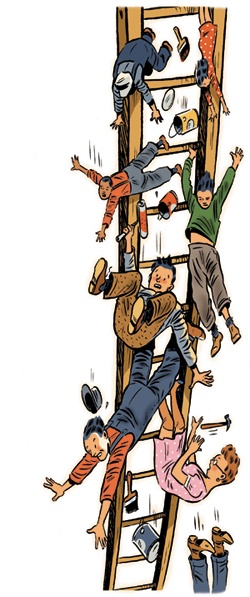Our family has a little wooden cabin by a stream in northern New Mexico. When people say “aw,” and I watch their eyes fill with desire for this spot on earth that surely must be heaven, I counter with, “You have absolutely no idea …” adding the eye squint and curled lip of a veteran who’s been paying with the same 10 pounds of flesh per year for 22 years. That’s what I lose on the never-ending “work in progress.”
Pictures of memorable projects flicker through my mind like old black-and-white movie clips. I watch as a circular floor sander throws me against the Franklin stove, which bends the chimney. Shortly thereafter, it pitches me out the screen door. I see myself during another project bawling my eyes out, blubbering, “I’m too old and too small,” while another glob of wet ceiling plaster lands on my head.
Last year, before I knew it, we were staining the outside of the cabin. The color of the 40-year-old part, a varnished yellow pine, never matched the redwood stain of the new part, and for eight years, when the sun went down in the Rocky Mountain west, instead of inspiring poetry, it lit up the difference like a zapping, brassy Las Vegas neon sign. So, I decided to “just see” whether the new stain on the old part would work. To my husband Bob’s huge disappointment, it did.
With cheap paintbrushes at the ready, we started the staining project at opposite ends, working our way around to each other—something akin to the way long marriages take care of business. At night we nursed our aching necks and backs. Finally, I got to the point where I needed to use the extension ladder to finish the 30-foot peaked front porch.
We folded the extended part of the ladder flat on top of the roof, and I climbed onto the pitch. Then, I overreached to get at the corners, jiggling the ladder in the process. I turned over onto my rump, and the ladder failed. The rung clamps worked loose, and I slid down like a freight train to the lip of the roof. My feet were trapped at the ankles, sandwiched between the extension and the bottom part of the ladder. I shouted for Bob, and he ran, but in trying to lift the ladder, he succeeded in freeing it to take a tighter, more excruciating bite. I screamed for him to call 9-1-1, and fortunately for us, the Taos Ski Valley volunteers responded in 5 minutes, lifted the ladder, pushed up the top part and freed my legs.
“You’ve got the ladder upside down,” one of the volunteers told me. “And you’re pretty lucky you hung up there at the side of the roof.”
“You’ve got to tie any ladder off, so it won’t fail,” said another one. “And you placed it way too shallow. It’s got to be a 70-degree pitch, not a 40, like you’ve got it here. Those clamps jiggled loose when you overreached.”
I felt this cold fist in the bottom of my stomach.
“Somebody was hanging Christmas lights on their cabin a couple of years ago,” said yet another volunteer, “and slid down two stories, broke both ankles, had multiple surgeries, spent a year in a wheelchair, more in walking casts, and is still using a cane.”
My stomach lurched.
I felt sick as more lessons in ladder safety were told Aesop’s fables-style. As the reality of what could have happened sank in, I blessed the day I was not alone on this job, as I had been on most other projects. We hired Edwardo, our jack-of-all-trades who’s rescued us more than once, to finish the staining. He rented scaffolding for 22 bucks and finished the job.
The Consumer Products Safety Commission estimated in 2004 that there are more than 164,000 ladder-related accidents in the United States each year requiring emergency room visits. Major causes for the accidents are slippery shoes or rungs, overreaching, stepladders that “rack” (teeter on one leg excessively, producing only three-leg contact), or, as in my case, failure of rung locks because of jiggling and shallow angle placement.
In the realm of total folly are falls that occur because people drop stuff, hitting the ladder’s legs and knocking them off. But the topper has to be those pitched off from a high position while they tried to “walk” a ladder to another spot. Unfortunately, most people don’t even know how or why they fell.
“If you have no flat ground, or a bad slope of land, the straight or extension ladder can slide out from under you. Faulty rung locks are another issue,” says Dr. Irving Ojalvo, a retired senior scientist from Columbia University. His company, Technology Associates (www.technology-assoc.com), is a consulting forensic engineering firm that provides accident reconstruction and analysis.
“Some stepladders have a propensity to twist easily,” he said. “You place one foot on the first rung, then you pull your body up with the opposite hand to get the second foot up. When doing this, one of the rear ladder legs comes up off the ground, and later you can be thrown off if you lean toward that raised leg. Then there’s the issue of ‘tying off’ the upper end of an extension ladder. More often than not, there’s nothing to ‘tie off’ to at the top. I’m not a fan of extension ladder upper tie-offs. They present a tremendous problem. What happens when you come down? You’ve got to undo the ties.”
Ojalvo likes European-design ladders, which look like an upside-down letter Y and have no top caps. There are also stabilization bars for making extension ladders safer. The use of small, hand-held paint sprayers instead of brushes can minimize the kind of movement that makes ladders unstable.
The cabin is now finished, and it looks beautiful. I figured out that I could attach brushes to a painter’s extension pole for the hard-to-reach places and single-sided razor blades for scraping paint splotches from windows. No ladder needed because, no matter how you look at it, being up there is just plain unsafe.
No more cha-cha routines for this do-it-yourselfer, and when I squint up and inventory all the missed spots, Bob is wont to say, “Don’t look up. Life, limb and prevention are above price to me, Sweetheart.”
“Are you speaking about mine, or yours?” I ask.
He just smiles.
Isabel Bearman Bucher has written about her Rio Grande River rafting trip and a childhood Christmas for Texas Co-op Power.


